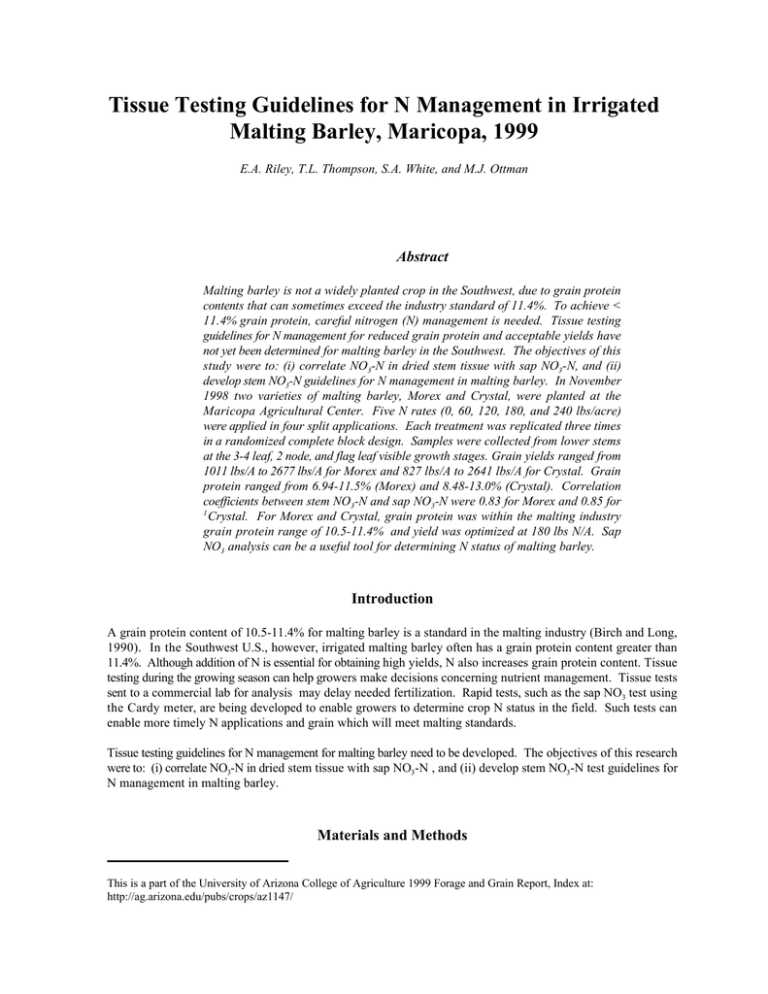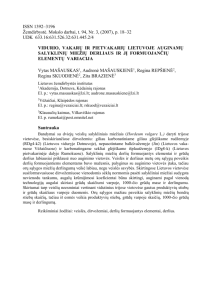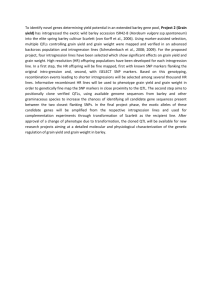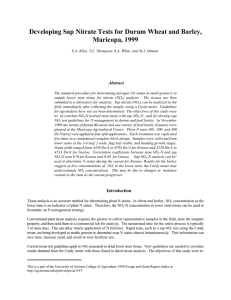Tissue Testing Guidelines for N Management in Irrigated Abstract
advertisement

Tissue Testing Guidelines for N Management in Irrigated Malting Barley, Maricopa, 1999 E.A. Riley, T.L. Thompson, S.A. White, and M.J. Ottman Abstract Malting barley is not a widely planted crop in the Southwest, due to grain protein contents that can sometimes exceed the industry standard of 11.4%. To achieve < 11.4% grain protein, careful nitrogen (N) management is needed. Tissue testing guidelines for N management for reduced grain protein and acceptable yields have not yet been determined for malting barley in the Southwest. The objectives of this study were to: (i) correlate NO3-N in dried stem tissue with sap NO3-N, and (ii) develop stem NO3-N guidelines for N management in malting barley. In November 1998 two varieties of malting barley, Morex and Crystal, were planted at the Maricopa Agricultural Center. Five N rates (0, 60, 120, 180, and 240 lbs/acre) were applied in four split applications. Each treatment was replicated three times in a randomized complete block design. Samples were collected from lower stems at the 3-4 leaf, 2 node, and flag leaf visible growth stages. Grain yields ranged from 1011 lbs/A to 2677 lbs/A for Morex and 827 lbs/A to 2641 lbs/A for Crystal. Grain protein ranged from 6.94-11.5% (Morex) and 8.48-13.0% (Crystal). Correlation coefficients between stem NO3-N and sap NO3-N were 0.83 for Morex and 0.85 for 1 Crystal. For Morex and Crystal, grain protein was within the malting industry grain protein range of 10.5-11.4% and yield was optimized at 180 lbs N/A. Sap NO3 analysis can be a useful tool for determining N status of malting barley. Introduction A grain protein content of 10.5-11.4% for malting barley is a standard in the malting industry (Birch and Long, 1990). In the Southwest U.S., however, irrigated malting barley often has a grain protein content greater than 11.4%. Although addition of N is essential for obtaining high yields, N also increases grain protein content. Tissue testing during the growing season can help growers make decisions concerning nutrient management. Tissue tests sent to a commercial lab for analysis may delay needed fertilization. Rapid tests, such as the sap NO3 test using the Cardy meter, are being developed to enable growers to determine crop N status in the field. Such tests can enable more timely N applications and grain which will meet malting standards. Tissue testing guidelines for N management for malting barley need to be developed. The objectives of this research were to: (i) correlate NO3-N in dried stem tissue with sap NO3-N , and (ii) develop stem NO3-N test guidelines for N management in malting barley. Materials and Methods This is a part of the University of Arizona College of Agriculture 1999 Forage and Grain Report, Index at: http://ag.arizona.edu/pubs/crops/az1147/ Two varieties of malting barley were planted at the Maricopa Agricultural Center on 19 Nov., 1998. The experiment was a randomized complete block design with five N rates (0, 60, 120, 180, and 240 lbs N/A) and three replications. The soil at this site is of the Casa Grande series and the dominant surface texture is sandy loam. Sudangrass was grown the previous season to remove residual N. Soil samples collected before planting contained 11 ppm NH4-N plus NO3-N and 9 ppm HCO3-available P. Before planting, P was broadcast at a rate of 50 lbs P 2 O 5/A as 0-45-0 and incorporated. All fertilizer was applied as urea 46-0-0 by hand in four split applications (Table 1). Plots were 13 by 20 ft. Morex and Crystal malting barley were planted using a grain drill with a 6 inch spacing at a seeding rate of 100 lbs/acre. Plots were border-flood irrigated. The irrigation dates were 20 Nov., 12 Jan., 14 Feb., 26 Mar., and 21 Apr. About 20 inches of water were applied and 1.47 inches of rain. Lower stem tissue was sampled from each plot for stem and sap NO3-N analysis on 5 Jan., 3 Feb., and 24 Feb. at Feekes GS 3, 7, and 10 (Large, 1954). Approximately 30 to 50 stems were collected in each plot. The stem samples were kept refrigerated for 24 hours and then split. Half of each sample was used for the sap extraction and the other half was dried in an oven at 65E C for 48 hours. The dried samples were ground, extracted and analyzed for nitrate using an ion-selective electrode. The sap extraction was accomplished by cutting the halved stems into small pieces and then expressing the sap with an arbor press. The sap was then collected and a drop was placed on the sensing module of a calibrated Cardy NO3 meter. Plots were harvested on 21 Apr. for Morex and 28 Apr. for Crystal using a small plot combine. The harvest area was 5 ft x 14 ft. Grain yield was adjusted to a 12% moisture basis. Test weight, kernel weight, grain protein content, lodging, and plant height were determined at harvest. Data were analyzed using analysis of variance. Linear regressions were used to determine correlation coefficients for sap versus stem NO3-N. Results and Discussion Grain yields were responsive to N applications up to 180 lbs N/A (Tables 2 and 3). Grain yield was maximized at 180 lbs N/A in both Morex (2677 lbs/A) and Crystal (2641 lbs/A). Grain protein was maximized at 240 lbs N/A in both Morex (11.5%) and Crystal (13.0%). For both varieties either lower or higher amounts of applied N resulted in loss of yield, while grain protein content increased with increasing applied N (Fig. 2). This may be due to the > 60% lodging at the 240 lbs N/acre N rates for both Morex. Grain yield and grain protein were significantly affected by N rate for both varieties. The grain protein only exceeded the 11.4% standard set by the malting industry at the highest N rate for Morex and at 180 and 240 lbs N/A for Crystal. Sap NO3-N and stem NO3-N were highly correlated for both Morex and Crystal (Fig. 1). Correlation coefficients (r2) for sap versus stem NO3-N were 0.84 for Morex and 0.85 for Crystal. Regression equations relating these two measurements are: Y = -1066.6 + 11.61*X for Morex and Y = -1263.1 + 11.5*X for Crystal, where X is sap NO3-N concentration and Y is stem NO3-N. These results suggest that rapid measurements of sap NO3-N using the Cardy meter can be converted for use with existing stem NO3-N guidelines. Sap NO3-N was highly correlated with N rate for both Morex and Crystal throughout the season (Figure 3). This relationship support a conclusion that sap NO3-N can be used as an indicator of plant N status. These preliminary results suggest that sap analysis can be substituted for conventional stem tissue analysis at the 2-3 leaf, 2 node, and flag leaf visible growth stages. These results can allow development of sap NO3-N test guidelines for optimizing yield and grain protein. Conclusions 1. Correlations between sap NO3-N and stem NO3-N are high. 2. Sap NO3-N concentration can be converted to stem NO3-N values using the regression equations above, for use with established tissue test guidelines for malting barley. References Birch, C.J. and K.E. Long. 1990. Effect of nitrogen on the growth, yield and grain protein content of barley (Hordeum vulgare). Australian Journal of Experimental Agriculture. 30, 237-242. Large, E.C. 1954. Growth stages in cereals. Illustrations of Feekes scale. Plant Physiology. 3, 128-129. Acknowledgments The assistance of Mark Rogers is greatly appreciated. Financial support for this project was received from the Arizona Grain Research and Promotion Council. Table 1. Nitrogen fertilizer schedule. Nitrogen Rates Date Stage 0 60 120 180 240 ---------------------------lbs N/A-------------------------20 Nov pre-plant 0 24 48 72 96 12 Jan 5-leaf 0 12 24 36 48 14 Feb jointing 0 12 24 36 48 3 Mar boot 0 12 24 36 48 Table 2. Influence of Nitrogen Rates on Grain Yield and Other Characteristics Variety Morex Crystal N rate Grain Yield Test Weight 1000 Kernel Weight Grain Protein Plant Height Lodging lbs/A lbs/A lbs/bu grams % inches % 0 1011 46.9 32.6 6.94 28.7 0 60 768 52.7 37.5 7.99 39.0 5 120 1554 52.1 38.1 9.35 43.0 13 180 2677 50.1 36.0 10.8 44.3 42 240 1881 46.5 32.6 11.5 46.0 63 0 827 49.0 41.0 8.48 31.0 13 60 2521 53.4 45.8 8.04 32.7 13 120 2327 55.0 45.0 8.81 34.3 23 180 2641 52.8 42.3 11.5 29.0 0 240 2422 51.9 42.7 13.0 35.7 25 Table 3. Analysis of variance summary for plant height, kernel weight, test weight, grain yield, and grain protein as affected by nitrogen rate. Variety Source df Plant height Kernel weight Test weight Grain yield Grain protein Lodging Morex Rep 2 NS NS NS NS NS NS N 4 ** ** ** ** ** ** Error 8 Rep 2 NS * NS NS NS NS N 4 NS * ** ** ** NS Error 8 Crystal *,**Significant at P # 0.05 and 0.01; NS, not significant.





